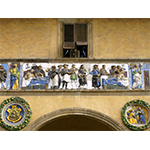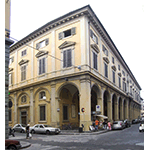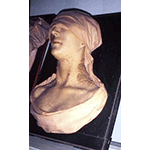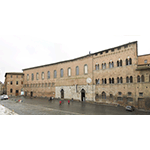Medicine in Tuscany

The central role conferred on empiricism in the Renaissance is undoubtedly one of the reasons for the early development of the science of anatomy in Tuscany. It was from these bases that the interest of scholars broadened to take into consideration the less visible causes and pathologies as well. To Tuscan physicians such as Targioni Tozzetti we owe precious intuitions on the disease of smallpox, while starting in the late 18th century, early attention was focussed on mental disorders. Bearing witness to this centuries-long scientific research are historic institutions that in many cases also represent precious examples of Renaissance and Baroque architecture.

The development of anatomical studies in the Renaissance
In the Renaissance, greater attention to experimentation in the various disciplines of knowledge resulted, in the medical field, in the further development of anatomical studies. Near the end of the 15th century Antonio Benivieni, a physician in the Florentine Hospital di Santa Maria Nuova, made over one hundred clinical observations, through careful post-mortem examinations, for which he is commonly considered the forerunner of pathological anatomy.
During this same period, progress in anatomical studies proceeded at the same rhythm as the publishing of works dedicated to pharmacology and therapeutics. In 1498 the first work of pharmocopeia, the Nuovo Receptario, was published in Florence.
Leonardo da Vinci's studies of the human body
In the early years of the 16th century Leonardo da Vinci devoted himself to studying the human body, practicing the dissection of cadavers in the Florentine Hospital of Santa Maria Nuova. Of this activity there remain numerous drawings, justly considered masterpieces of scientific anatomy. His observations, focussed on comparison between the human body and the machine, revolutionised traditional medical science. Leonardo was the first to represent segments of the skeleton and to use the example of the lever to explain how the joints worked. He represented the muscular fascia by wires or cords, revealing their mechanical action. In his studies on the cervical vertebrae, he compared the muscles that support the neck to the shrouds that hold up the mast in a ship.

The hospital schools of surgery
In 16th century Tuscany, surgery was taught not only at the University of Pisa but also in various schools of surgery annexed to hospitals, such as that of the Ceppo Hospital in Pistoia and the School of Medicine and Surgery at the Santa Maria Nuova Hospital in Florence. And it was in the Florence hospital that, at the order of Cosimo I de' Medici, all of the physicians and surgeons in Tuscany had to take an examination qualifying them for the medical profession. It was during those years that surgery, thanks also to the fundamental contribution of Andrea Vesalio in the field of anatomical-physiological studies (De humani corporis fabrica, 1543), came to be considered no longer an inferior craft left almost exclusively to barbers, but a subject to be included in the curriculum of a doctor.
Medical research within the sphere of the Accademia del Cimento
Within the sphere of the Galilean Accademia del Cimento (1657-1667), the Florentine alcohol thermometer was developed, starting from the thermoscope. This instrument was employed not only in meteorology but also in the medical field. A variation of the instrument, the so-called "frog thermometer", was used to measure the temperature of the human body (the Academy’s thermometers are now displayed at the Institute and Museum of the History of Science in Florence). The members of the Academy also carried out their activity using a crucially important instrument, the microscope, invented in the early 17th century.
A decisive step in the development of medicine, especially as regards experimental research, is represented by the ingenious experiments of Francesco Redi, a physician from Arezzo who, through an exemplary experimental procedure, demonstrated the falsity of the belief in spontaneous generation. Another member of the Cimento, Giovanni Alfonso Borelli, conducted very important studies on the bone structure of animals in relation to their weight and movement. Particularly significant were the studies of Lorenzo Bellini, a pupil of Borelli, who in 1653 explained how, in the kidneys, the blood is separated from what he called the "superfluous serosity", that is, the urine.
-
 Museo Galileo - Istituto e Museo di Storia della Scienza [Institute and Museum of the History of Science]
Museo Galileo - Istituto e Museo di Storia della Scienza [Institute and Museum of the History of Science] -
 Francesco Redi
Francesco Redi -
 Giovanni Alfonso Borelli
Giovanni Alfonso Borelli -
 From the thermoscope to the thermometer
From the thermoscope to the thermometer -
 Origin and development of the microscope
Origin and development of the microscope -
 Court Scientists. The Art of Experimentation in the Accademia Galileiana del Cimento (1657-1667)
Court Scientists. The Art of Experimentation in the Accademia Galileiana del Cimento (1657-1667)
-
 Cluster thermometer
Cluster thermometer
-
 Fifty-degree thermometers
Fifty-degree thermometers
-
 "Frog" thermometer
"Frog" thermometer
-
 Compound microscope, Galilean
Compound microscope, Galilean
-
 Francesco Redi, scienziato e poeta alla Corte dei Medici (italian only)
Francesco Redi, scienziato e poeta alla Corte dei Medici (italian only)
Studies on blood and the first transfusions
Observations on the circulation of the blood, which had begun with the English physiologist William Harvey, who had identified the heart as the pump that mechanically regulates the dynamics of the circulatory motion, were conducted in Tuscany in the 17th century by Marcello Malpighi. In 1661, utilising the microscope, Malpighi proved the existence of the capillaries that serve as connection between the venous and the arterial vascular systems. And it was in Tuscany that the first experiments in blood transfusion were made. In 1654 Francesco Folli da Poppi, inspired by his own experiments in grafting plants, performed blood transfusions, believing that they could cure diseases and fortify persons of weak constitution.
Medical research in the 18th century
In the 18th century Giovan Battista Morgagni, one of the outstanding figures in the field of medical studies, established a causal relationship between diseases and anatomical lesions in the organs affected by them, observations that still today merit him the title of founder of Pathological Anatomy. In Tuscany, anatomical studies were developed also through the work of Abbot Felice Fontana. In the Museo di Fisica e Storia Naturale, he set up a waxworks shop for the reproduction of anatomical parts to be used in teaching, collaborating with famous wax-modellers in preparing the anatomical wax figures displayed today in the Florentine Museum of "La Specola".
The smallpox epidemic
In 1756 Tuscany was swept by a violent epidemic of smallpox. The grand-ducal physician Giovanni Targioni Tozzetti inoculated six orphans with the cowpox virus. This practice, only recently experimented, did not meet with the unanimous approval of the scientific world. The enlightened reformist policy of the Lorraines brought Tuscany to the forefront in the affirmation of this type of prevention. Grand Duke Peter Leopold of Lorraine himself underwent vaccination at the advice of his mother, the Austrian Empress Maria Teresa, who had contracted the disease in 1767. The Grand Duke was vaccinated by the physician Angelo Gatti at the Villa of Poggio Imperiale at 11 o'clock on the morning of May 13, 1769.

The origins of psychiatry
During the last years of the 18th century, Tuscany accepted the premises for the constitution of psychiatry as a discipline with a status of its own. Vincenzo Chiarugi, in his crucially important work Della pazzia in genere e in specie (On madness in general and in its specific types) considered mental illnesses on the same level as other pathologies, and believed that the mentally ill should be treated in special facilities and not segregated as had been the custom up to then. For this purpose, the Bonifazio Hospital in Florence was delegated to accommodate psychiatric patients coming from the now inadequate Santa Dorotea Hospital which, towards the end of the 18th century, had been the model for the new Psychiatric Hospital of Lucca. In the 19th century the new sensitivity toward pathologies of this kind led to the founding and reorganising of other hospitals, built to satisfy the new requisites; some examples are the former Psychiatric Hospital of San Niccolò in Siena, the former Psychiatric Hospital of San Salvi in Florence and the former Psychiatric Hospital of Arezzo.
-
 Ex Ospedale di Bonifazio [Former Bonifazio Hospital]
Ex Ospedale di Bonifazio [Former Bonifazio Hospital] -
 Ex Ospedale di Santa Dorotea [Former Santa Dorotea Hospital]
Ex Ospedale di Santa Dorotea [Former Santa Dorotea Hospital] -
 Ex Ospedale Psichiatrico San Niccolò [Former San Niccolò Psychiatric Hospital]
Ex Ospedale Psichiatrico San Niccolò [Former San Niccolò Psychiatric Hospital] -
 Ex Ospedale Psichiatrico di Arezzo [Former Psychiatric Hospital of Arezzo]
Ex Ospedale Psichiatrico di Arezzo [Former Psychiatric Hospital of Arezzo] -
 Ex Ospedale psichiatrico di Fregionaia [Former Psychiatric Hospital of Fregionaia]
Ex Ospedale psichiatrico di Fregionaia [Former Psychiatric Hospital of Fregionaia] -
 Ex Ospedale Psichiatrico di San Salvi [Former San Salvi Psychiatric Hospital]
Ex Ospedale Psichiatrico di San Salvi [Former San Salvi Psychiatric Hospital]
The local obstetrical units
Important innovations took place also in the field of obstetrics. Giuseppe Vespa, who had studied at the Paris School of Obstetrics, began to teach at the Hospital di Santa Maria Nuova in Florence toward the middle of the 18th century, just a few months after the first Italian Chair of Obstetrics had been instituted at Bologna. Thanks to him, Local Obstetrical Units were set up in every quarter of the city, each with a midwife and a surgeon to be called in when necessary. Each surgeon was assisted by two of the best students in surgery. The Local Units thus served an educational purpose as well as providing important centres for the organisation of emergencies.

Medical research in the 19th century
The finest 19th-century work on anatomy was written by Paolo Mascagni, who conducted a fundamentally important study of the lymphatic vessels. In 1823, seven years after his death, the Anatomia universa, the monumental work to which the scientist had devoted himself for years, was published in Pisa.
The 19th century marked a decisive moment in the sphere of medical-biological studies, with the definition of questions such as reproduction, the determination of sex and hereditary traits. In Tuscany the activity of Giovanni Battista Amici, a scientist from Modena, was highly important. His innovations in the field of microscope construction provided researchers in anatomy with efficacious instruments for studying the structure of minute bodies. The Pistoian Filippo Pacini, the first professor in Italy to teach a course in Microscopic Anatomy, discovered the tactile corpuscles in 1853, while still a student, described the structure of the retina and, a forerunner in the field of bacteriology, described the cholera vibrio. He was, together with Pietro Betti and Maurizio Bufalini, one of the founders of the Florentine Physical Medicine Society, at which the Pathological Museum was set up.
-
 Museo Anatomico dell'Università degli Studi di Firenze [University of Florence Anatomical Museum]
Museo Anatomico dell'Università degli Studi di Firenze [University of Florence Anatomical Museum] -
 Museo di Anatomia Patologica dell'Università degli Studi di Firenze [University of Florence Museum of Pathological Anatomy]
Museo di Anatomia Patologica dell'Università degli Studi di Firenze [University of Florence Museum of Pathological Anatomy] -
 Museo di Anatomia Umana del Dipartimento di Morfologia Umana e Biologia Applicata dell'Università degli Studi di Pisa [University of Pisa Museum of Human Anatomy, Department of Human Morphology and Applied Biology]
Museo di Anatomia Umana del Dipartimento di Morfologia Umana e Biologia Applicata dell'Università degli Studi di Pisa [University of Pisa Museum of Human Anatomy, Department of Human Morphology and Applied Biology] -
 Filippo Pacini
Filippo Pacini -
 Giovanni Battista Amici
Giovanni Battista Amici -
 Reflecting microscope
Reflecting microscope

The historic places of medicine
The complex history of medicine in Tuscany can be evoked in part starting from the ancient Hospital of Santa Maria della Scala, within whose circle of influence lay numerous fortified farms, such as the Cuna Grange and the Serre Grange which, in addition to providing for the subsistence of the main centre, offered lodging and assistance to travellers. Among these relief and charity institutions were some of the greatest historic hospitals in Tuscany (the Misericordia e Dolce Hospital in Prato, the Ceppo Hospital in Pistoia, the Santa Chiara Hospital in Pisa, the Hospital "degli Innocenti" and that of San Giovanni di Dio in Florence), as well as numerous Misericordia Confraternities, an eloquent example of which is provided by the Museum of the Confraternity in Anghiari. Noteworthy as regards the history of medicine are, in addition to the various thermal stations, the numerous historic pharmacies scattered over the territory; among them, special mention is due the "Officina Profumo Farmaceutica di Santa Maria Novella" in Florence, the "Spezieria di Santa Fina" in San Gimignano, the pharmacy of the Archi-coenoby of Monte Oliveto Maggiore, the pharmacy of the Camaldoli Monastery, the pharmacy of the La Verna Sanctuary, the "Spezieria dello Spedale Serristori" in Figline Valdarno and the pharmacy of the "Certosa" at Calci.
-
 Antica Farmacia del Monastero di Camaldoli [Ancient Pharmacy of the Camaldoli Monastery]
Antica Farmacia del Monastero di Camaldoli [Ancient Pharmacy of the Camaldoli Monastery] -
 Antica Spezieria dello Spedale Serristori [Ancient Pharmacy of the Serristori Hospital]
Antica Spezieria dello Spedale Serristori [Ancient Pharmacy of the Serristori Hospital] -
 Centro di Documentazione per la Storia dell'Assistenza e della Sanità Fiorentina - Antico Ospedale di San Giovanni di Dio [Documentation Centre for the History of Florentine Social Assistance and Medicine - Ancient Hospital of San Giovanni di Dio]
Centro di Documentazione per la Storia dell'Assistenza e della Sanità Fiorentina - Antico Ospedale di San Giovanni di Dio [Documentation Centre for the History of Florentine Social Assistance and Medicine - Ancient Hospital of San Giovanni di Dio] -
 Centro Documentazione Tutela e Valorizzazione del Patrimonio Culturale e Scientifico della Sanità Pubblica [Documentation Centre for the Tutelage and Promotion of the Cultural and Scientific Heritage of Public Health]
Centro Documentazione Tutela e Valorizzazione del Patrimonio Culturale e Scientifico della Sanità Pubblica [Documentation Centre for the Tutelage and Promotion of the Cultural and Scientific Heritage of Public Health] -
 Centro Universitario per la Tutela e la Valorizzazione dell'Antico Patrimonio Scientifico Senese [University Centre for Safeguarding and Promoting Siena's Ancient Scientific Heritage]
Centro Universitario per la Tutela e la Valorizzazione dell'Antico Patrimonio Scientifico Senese [University Centre for Safeguarding and Promoting Siena's Ancient Scientific Heritage] -
 Complesso Museale di Santa Maria della Scala [Santa Maria della Scala Museum Complex]
Complesso Museale di Santa Maria della Scala [Santa Maria della Scala Museum Complex] -
 Confraternita di Misericordia di Buonconvento [Confraternity of the Misericordia of Buonconvento]
Confraternita di Misericordia di Buonconvento [Confraternity of the Misericordia of Buonconvento] -
 Farmacia dell'Archicenobio di Monte Oliveto Maggiore [Pharmacy of the Archicoenoby of Monte Oliveto Maggiore]
Farmacia dell'Archicenobio di Monte Oliveto Maggiore [Pharmacy of the Archicoenoby of Monte Oliveto Maggiore] -
 Grancia di Cuna [The Cuna Grange]
Grancia di Cuna [The Cuna Grange] -
 Istituto degli Innocenti - Ospedale degli Innocenti [Institute and Hospital 'degli Innocenti']
Istituto degli Innocenti - Ospedale degli Innocenti [Institute and Hospital 'degli Innocenti'] -
 Museo del Santuario de La Verna [Sanctuary of La Verna Museum]
Museo del Santuario de La Verna [Sanctuary of La Verna Museum] -
 Museo della Confraternita di Misericordia [Museum of the Misericordia Confraternity]
Museo della Confraternita di Misericordia [Museum of the Misericordia Confraternity] -
 Museo dell'Antica Grancia di Serre [Museum of the Ancient Serre Grange]
Museo dell'Antica Grancia di Serre [Museum of the Ancient Serre Grange] -
 Museo Nazionale della Certosa di Calci [National Museum of the Carthusian Monastery at Calci]
Museo Nazionale della Certosa di Calci [National Museum of the Carthusian Monastery at Calci] -
 Officina Profumo Farmaceutica di Santa Maria Novella [Perfume and Pharmaceutical Works of Santa Maria Novella]
Officina Profumo Farmaceutica di Santa Maria Novella [Perfume and Pharmaceutical Works of Santa Maria Novella] -
 Ospedale della Misericordia e Dolce [Misericordia e Dolce Hospital]
Ospedale della Misericordia e Dolce [Misericordia e Dolce Hospital] -
 Spedale del Ceppo - Museo dei Ferri Chirurgici [Hospital of Ceppo - Museum of Surgical Instruments]
Spedale del Ceppo - Museo dei Ferri Chirurgici [Hospital of Ceppo - Museum of Surgical Instruments] -
 Spedali Riuniti di Santa Chiara [Santa Chiara Associated Hospitals]
Spedali Riuniti di Santa Chiara [Santa Chiara Associated Hospitals] -
 Spezieria di Santa Fina [Santa Fina Pharmacy]
Spezieria di Santa Fina [Santa Fina Pharmacy] -
 Venerabile Arciconfraternita della Misericordia di Firenze [Venerable Arch-confraternity of the Florentine Misericordia]
Venerabile Arciconfraternita della Misericordia di Firenze [Venerable Arch-confraternity of the Florentine Misericordia] -
 Thermal baths in Tuscany
Thermal baths in Tuscany
****************************
Texts by Antonella Gozzoli
English translation by Catherine Frost
Last update 25/gen/2008


